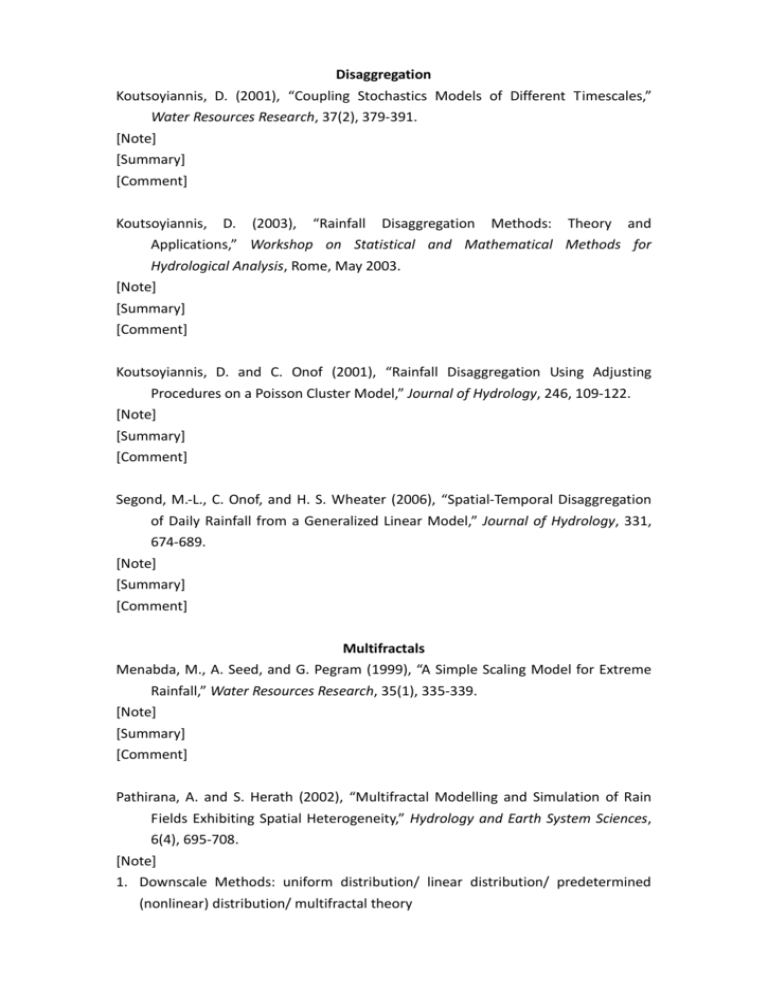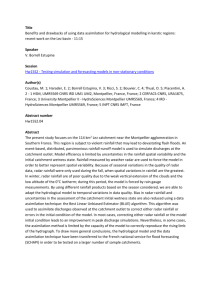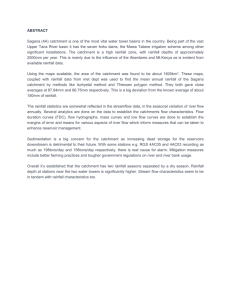ReferenceReview
advertisement

Disaggregation Koutsoyiannis, D. (2001), “Coupling Stochastics Models of Different Timescales,” Water Resources Research, 37(2), 379-391. [Note] [Summary] [Comment] Koutsoyiannis, D. (2003), “Rainfall Disaggregation Methods: Theory and Applications,” Workshop on Statistical and Mathematical Methods for Hydrological Analysis, Rome, May 2003. [Note] [Summary] [Comment] Koutsoyiannis, D. and C. Onof (2001), “Rainfall Disaggregation Using Adjusting Procedures on a Poisson Cluster Model,” Journal of Hydrology, 246, 109-122. [Note] [Summary] [Comment] Segond, M.-L., C. Onof, and H. S. Wheater (2006), “Spatial-Temporal Disaggregation of Daily Rainfall from a Generalized Linear Model,” Journal of Hydrology, 331, 674-689. [Note] [Summary] [Comment] Multifractals Menabda, M., A. Seed, and G. Pegram (1999), “A Simple Scaling Model for Extreme Rainfall,” Water Resources Research, 35(1), 335-339. [Note] [Summary] [Comment] Pathirana, A. and S. Herath (2002), “Multifractal Modelling and Simulation of Rain Fields Exhibiting Spatial Heterogeneity,” Hydrology and Earth System Sciences, 6(4), 695-708. [Note] 1. Downscale Methods: uniform distribution/ linear distribution/ predetermined (nonlinear) distribution/ multifractal theory 2. Rainfall variability in space can be explained as a random cascade process (reported in the literature). 3. Rainfall = spatial heterogeneity (deterministic) + random variability (multifractal process yet statistically uniform at regional scales) 4. When the rainfall is accumulated over a long time period, the randomness reduces to a uniform field due to the averaging effect, and hence, the deterministic effect predominates. 5. Proposed Model: Rainfall = M * G; (M: multifractal modelling, G: invariant over a long accumulation) 6. Tachikawa, Y., M. Hiwasa, and K. Takara, “Spatial rainfall field simulation with random cascade introducing orographic effects on rainfall.” [Note] 1. A space rainfall model, based on a random cascade process, disaggregates a regionally averaged rainfall amount to generate spatial distributions of rainfall. 2. A topographic effect (the dependence line on topographic elevations, DLTE) on rainfall spatial distributions is incorporated into a random cascade generator to realise more realistic rainfall field simulations. 3. Random cascade model ni R0 L0 b n n W i j j 1 Rainfall volume in the sub-area i at the n th level of disaggregation step= average rainfall intensity of the initial area * the length of the study area / (branching number ^ n th level) * random cascade generators 4. Random cascade generator (beta-lognormal model) W=B*Y Random cascade generator = the random variant expressing the condition whether it rains in the sub-area or not * the random variant representing the weight for assigning a rainfall volume into the sub-areas. B is related to the model parameter, Beta; Y is related to the model parameter, Alpha Square. Both Beta and Alpha Square can be estimated by observed radar data (Jothityangkoon, et al., 2000). 5. Introduce DLTE into random cascade generator (1) DLTE presents an obvious dependence relation between accumulated rainfall distributions and topographic elevations. log k (T ) (T ) a z k b (2) Apply a deterministic topographic multiplier matrices G derived by DLTE to random cascade generator. In this work, G is estimated from radar rainfall data. W=B*Y*G 6. The random cascade generator with introducing G only at the 6th level of disaggregation presents a linear relationship with the elevations, which is in good agreement with the relationship introduced by the DLTE. Radar Bray, M. T. J., D. Han, I. Cluckie, and M. Rico-Ramirez, “Analysis of weather radar and rain gauges for flood forecasting,” in Proceedings of the European conference on Flood Risk Management Research into Practice, Oxford, UK, 30 Sep. – 2 Oct., 2008. [Note] 1. Weather radar in the UK now consists of 15 C-band weather radars and 2 additional sites are planned with Northumbrian Water PLC and Anglian Water PLC. 2. A study was conducted to analyse rainfall data measured simultaneously by a dense raingauge network and weather radars over an experimental catchment. The relevant weather variables (wind, temperature, relative humidity at different elevations) for the major storms were modelled by MM5 (a numerical weather model). 3. Principal Components Analysis (PCA) to assess the uncertainty and redundancy of the existing raingauge network (nearly zero = many redundant raingauge stations; no nearly zero = the network may not be adequate). 4. Cluster Analysis to identify the best location of for the given number of rain gauges found by the PCA. 5. Case study: Brue Catchment (49 raingauges, 3 radars) a. PCA analysis: 3 raingauges are enough. b. Cluster Analysis: best locations change annually. 6. Conclusion: a. For the Brue catchment just one rain gauge can give a more accurate measurement of the catchment average rainfall than weather radar (the result could be different for larger catchments). b. The rainfall field over the Brue catchment has high spatial and temporal variability. c. Radar was generally more reliable than MM5 both in terms of accurate detection and rainfall quantities for all events studied. d. The information from rain gauge, weather radar, and numerical weather model should be integrated to provide the best rainfall estimation. Chumchean, S., A. Seed, and A. Sharma (2003), “Effect of Radar Beam Geometry on Radar Rainfall Estimation,” in Weather Radar Information and Distributed Hydrological Modelling, edited by Y. Tachikawa, B. E. Vieux, K. P. Georgakakos, and E. Nakakita, IAHS Publication no. 282, 2003. [Note] [Summary] [Comment] Emmanouil, N. A. and W. F. Krajewski (1999), “Real-Time Radar Rainfall Estimation,” Journal of Atmospheric and Oceanic Technology, 16, 189-197. [Note] [Summary] [Comment] Gerstner, E.-M. and G. Heinemann (2008), “Real-Time Areal Precipitation Determination from Radar by Means of Statistical Objective Analysis,” Journal of Hydrology, 352, 296-308. [Note] 1. This paper presents a complete pipeline for real-time radar precipitation determination using a modified statistical objective analysis method with the aid of ground measurements to significantly improve the quality of the radar-derived precipitation. 2. A statistical objective analysis (SOA) can adjust the radar data pixel by pixel with the help of the rain gauge measurements. 3. Radar data range: 50 km radius; spatial resolution: 250 m; temporal resolution; 15 min for 1998 and 5-10 min for 1999. Ground precipitation measurement: 21 rain gauges with temporal resolution of 5 min and 24 hour. 4. Processing pipeline: preprocessed data reflectivity rain rate (Z-R relationships) if convective, redo preprocessing bias correction advection correction precipitation accumulation SOA areal precipitation (1) standard preprocessing of radar data (2) 5. sj. Fabry, F., A. Bellon, M. R. Duncan, and G. L. Austin (1994), “High resolution rainfall measurements by radar for very small basins: the sampling problem reexamined,” Journal of Hydrology, 161, pp. 415-428. [Note] 1. An accumulation method considering the storm







